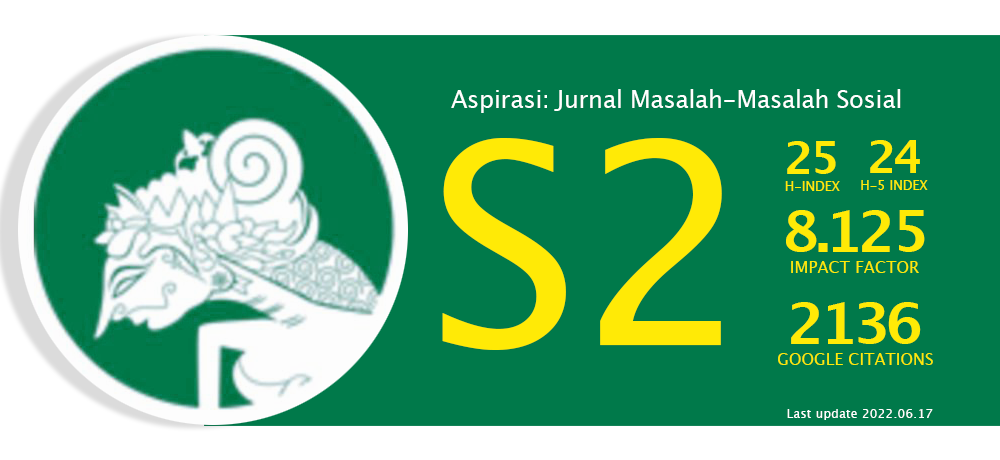Hubungan Religiositas dan Kesehatan Mental pada Remaja Pesantren di Tabanan
Abstract
Many studies prove that religiosity is related to mental health. Islamic boarding schools are considered capable of strengthening religiosity in adolescents. Many parents put their children into Islamic boarding schools in the hope that their children will be positive adults. The problem that must be answered in this research is: Is there a relationship between religiosity and mental health of adolescents in Islamic boarding schools? Is there a relationship between the dimensions of religiosity and mental health? The results showed that the correlation value between religiosity scores and mental health scores in participants, r = 0.31, p <0.01, two-tailed. These results indicate that there is a positive and significant relationship between religiosity scores and mental health scores in Islamic boarding schools adolescent with 9.61% of mental health variance can be explained by religiosity, while the rest is caused by other factors. While other results from this study indicate that among the dimensions of mental health, religiosity has a positive and significant relationship only with social welfare, namely r = 0.3, p <0.01, two-tailed. This means that the higher the level of religiosity felt by Islamic boarding school adolescents, the higher the dimensions of their social welfare, and vice versa.
Abtrak
Banyak penelitian membuktikan bahwa religiusitas terkait dengan kesehatan mental. Pesantren dianggap mampu memperkuat religiusitas pada remaja. Banyak orang tua memasukkan anak-anak mereka ke pesantren dengan harapan anak-anak mereka akan menjadi orang dewasa yang positif. Masalah yang harus dijawab dalam penelitian ini adalah: Apakah ada hubungan antara religiusitas dan kesehatan mental remaja di pondok pesantren remaja? Apakah ada hubungan antara dimensi religiusitas dan kesehatan mental? Hasil penelitian menunjukkan bahwa nilai korelasi antara skor religiusitas dan skor kesehatan mental pada partisipan, yaitu r = 0.31, p < 0.01, two tailed. Hasil ini menunjukkan bahwa terdapat hubungan positif dan signifikan antara skor religiusitas dan skor kesehatan mental pada remaja pesantren dengan 9,61% varians kesehatan mental dapat dijelaskan oleh religiusitas, sedangkan sisanya disebabkan oleh faktor lain. Sementara hasil lain dari penelitian ini menunjukkan bahwa di antara dimensi kesehatan mental, religiusitas memiliki hubungan positif dan signifikan hanya dengan kesejahteraan sosial, yaitu r = 0.3, p < 0.01, two tailed. Ini berarti bahwa semakin tinggi tingkat religiusitas yang dirasakan oleh remaja pesantren, maka semakin tinggi pula dimensi kesejahteraan sosial mereka, begitu pun sebaliknya.
Keywords
Full Text:
pdfReferences
Abu-Raiya, H. (2013). On the links between religion, mental health, and inter-religious conflict: a brief summary of empirical research. Isr J Psychiatry Relat Sci, 50(2), 130–9.
Aletti, M. (2005). Religion as an illusion: Prospects for and problems with a psychoanalytical model. Archive for the Psychology of Religion, 27(1), 1–18.
Bonelli, R. M., & Koenig, H. G. (2013). Mental disorders, religion and spirituality 1990 to 2010: a systematic evidence-based review. Journal of religion and health, 52(2), 657–673.
Bonelli, R., Dew, R. E., Koenig, H. G., Rosmarin, D. H., & Vasegh, S. (2012). Religious and spiritual factors in depression: review and integration of the research. Depression research and treatment, 2012.
D. Ancok & F.N. Suroso. (2001). Psikologi Islami: Solusi Islam atas Problem-Problem Psikologi. Cetakan 4. Yogyakarta: Pustaka Pelajar.
Goldie, I., Dowds, J., & C. O’Sullivan. (2013). Mental health and inequalities. Mental Health Foundation, Background Paper 3, 2013.
Gravetter, FJ., Forzano LB. (2009). Research Methods for the Behavioral Sciences. Belmont, CA: Wadsworth Cengage Learning.
Guerra, N.G, Wiliamson, A.A, & Molina, B.L. (2012). Normal Development Infancy, Childhood, And Adolescence. Geneva: International Association for Child and Adolescence Psychiatry and Allied Professions 2012.
Hill, J. (1983). Early adolescence: A framework. Journal of Early Adolescence, 3, 1–21.
Hurlock, E.B. (1993). Psikologi Perkembangan Suatu Pendekatan Sepanjang Rentang Kehidupan.Jakarta: Erlangga.
Iro, Fk. (2018). Kekerasan Remaja Indonesia Mencapai 50 Persen. Retrieved from http://fk.ugm.ac.id/kekerasan-remaja-indonesia-mencapai-50-persen, on 17 Juli 2019.
Keyes, C.L.M. (1998). Social wellbeing. Social Psychology Quarterly, 61, 121–140.
Keyes, C.L.M. (2002). The mental health continuum: From languishing to flourishing in life. Journal of Health and Social Behavior, 43, 207–222.
Keyes, C.L.M. (2005). Mental Illness and/or mental health? Investigating axioms of the complete state model of health. Journal of Consulting and Clinical Psychology, 73, 539–548.
Keyes, C.L.M. (2006). Mental health in adolescence: Is America’s youth flourishing? American Journal of Orthopsychiatry, 76, 395–402.
Keyes, C.L.M. (2007). Promoting and protecting mental health as flourishing: A complementary strategy for improving national mental health. American Psychologist, 62, 95–108.
Koohsar, A. A. H., & Bonab, B. G. (2011). The Relation between quality of the image of God with anxiety and depression in college students. Procedia-Social and Behavioral Sciences, 29, 252–256.
Leeming, D. A., Madden, K. W., & Marlan, S. (Eds.). (2014). Encyclopedia of psychology and religion (p. 287). Springer.
M.N. Ghufron & Risnawita. (2010). Teori-teori Psikologi. Yogyakarta: Ar-Ruzz Media.
Muhyani. (2012). Pengaruh Pengasuhan Orang Tua dan Peran Guru di Sekolah Menurut Persepsi Murid Terhadap Kesadaran Religius dan Kesehatan Mental. Jakarta: Kementerian Agama.
Papalia, D.E., Olds, S.W., & Feldman, R.D. (2009). Human Development (11th Ed). United States: Mc Graw-Hill Companies, Inc.
Peters, R.D. (1988). Mental health promotion in children and adolescents: an emerging role for psychology. Queen’s University & Beechgrove Children’s Centre.
Putro, K.Z. (2017). Memahami Ciri dan Tugas Perkembangan Masa Remaja. Aplikasia: Jurnal Aplikasi Ilmu-Ilmu Agama, 17(1), 2017, 25–32.
Rosmarin, D. H., Bigda-Peyton, J. S., Kertz, S. J., Smith, N., Rauch, S. L., & Björgvinsson, T. (2013). A test of faith in God and treatment: The relationship of belief in God to psychiatric treatment outcomes. Journal of affective disorders, 146(3), 441–446.
Rusydi, A. (2012). Religiositas dan Kesehatan Mental: Studi pada Aktivis Jamaáh Tabligh Jakarta Selatan. Jakarta: Young Progressive Muslim.
Ryff, C.D. (1989). Happiness is everything, or is it? Explorations on the meaning of psychological wellbeing. Journal of Personality and Social Psychology, 57, 1069–1081.
Ryff, C.D., & Keyes, C.L.M. (1995). The structure of psychological wellbeing revisited. Journal of Personality and Social Psychology, 69, 719–727.
Santrock, J.W. (2003). Adolescence. New York: McGraw-Hill.
Sarwono, S.W. (2006). Psikologi Remaja. Jakarta: PT Raja Grafindo Persada.
Silton, N. R., Flannelly, K. J., Galek, K., & Ellison, C. G. (2014). Beliefs about God and mental health among American adults. Journal of Religion and Health, 53(5), 1285–1296.
Steinberg, L. (1993). Adolescence (3rd Ed.).USA: McGraw-Hill, Inc.
Sullivan, S., Pyne, J. M., Cheney, A. M., Hunt, J., Haynes, T. F., & Sullivan, G. (2014). The pew versus the couch: Relationship between mental health and faith communities and lessons learned from a VA/clergy partnership project. Journal of religion and health, 53(4), 1267–1282.
Weber, S. R., & Pargament, K. I. (2014). The role of religion and spirituality in mental health. Current opinion in psychiatry, 27(5), 358–363.
Worthington Jr, E. L., Wade, N. G., Hight, T. L., Ripley, J. S., McCullough, M. E., Berry, J. W., & O'Connor, L. (2003). The Religious Commitment Inventory--10: Development, refinement, and validation of a brief scale for research and counseling. Journal of counseling psychology, 50(1), 84.
Y.B. Mangunwijaya. (1992). Sastra dan Religiositas. Yogyakarta: Penerbit Kanisius.
DOI: https://doi.org/10.46807/aspirasi.v10i2.1428
Refbacks
- There are currently no refbacks.







